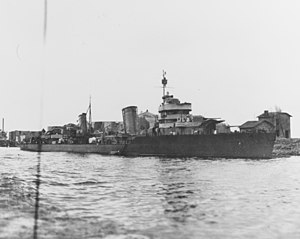 Leningrad-class destroyer Leningrad in Leningrad, the city which the lead ship is named after, June 1944
| |
| History | |
|---|---|
| Name | Leningrad (Russian: Ленингра́д) |
| Namesake | Leningrad |
| Ordered | 1st Five-Year Plan |
| Builder | Shipyard 190 (Zhdanov), Leningrad |
| Yard number | 450 |
| Laid down | 5 November 1932 |
| Launched | 17 November 1933 |
| Commissioned | 5 December 1936 |
| Out of service | 18 April 1958 |
| Renamed |
|
| Reclassified |
|
| Fate | Sunk after being used as target ship, May 1963 |
| General characteristics (as built) | |
| Class and type | Leningrad-class destroyer |
| Displacement | |
| Length | 127.5 m (418 ft 4 in) (o/a) |
| Beam | 11.7 m (38 ft 5 in) |
| Draft | 4.06 m (13 ft 4 in) |
| Installed power |
|
| Propulsion | 3 shafts; 3 geared steam turbines |
| Speed | 40 knots (74 km/h; 46 mph) |
| Range | 2,100 nmi (3,900 km; 2,400 mi) at 20 knots (37 km/h; 23 mph) |
| Complement | 250 (311 wartime) |
| Sensors and processing systems | Arktur hydrophones |
| Armament |
|
Leningrad (Russian: Ленингра́д) was the lead ship of her class of six destroyer flotilla leaders built for the Soviet Navy during the 1930s, one of the three Project 1 variants. Completed in 1936, the ship was assigned to the Baltic Fleet and played a minor role in the Winter War against Finland in 1939–1940. After the start of Operation Barbarossa, the German invasion of the Soviet Union in June 1941, Leningrad covered minelaying operations, laid mines herself, and provided naval gunfire support to Soviet units. She escorted ships during the evacuation of Tallinn, Estonia, in August and then bombarded German troops during the Siege of Leningrad. The ship was assigned to evacuate Soviet troops from their enclave in Hanko, Finland, in November, but was badly damaged by mines en route and forced to return to Leningrad for repairs. After they were completed, Leningrad resumed shelling German positions and continued to do so until the Leningrad–Novgorod Offensive drove them away from the city in January 1944.
After the war, the ship was modernized in 1951–1954. She became a target ship in 1958 and was renamed TsL-75. The ship was transferred to the Northern Fleet the following year and was disarmed in 1960. She was converted into an accommodation ship that year and was renamed PKZ-16. The hulk was reconverted into a target ship, SM-5, in 1962. The following year the ship was used to test anti-ship missiles and sank afterwards.